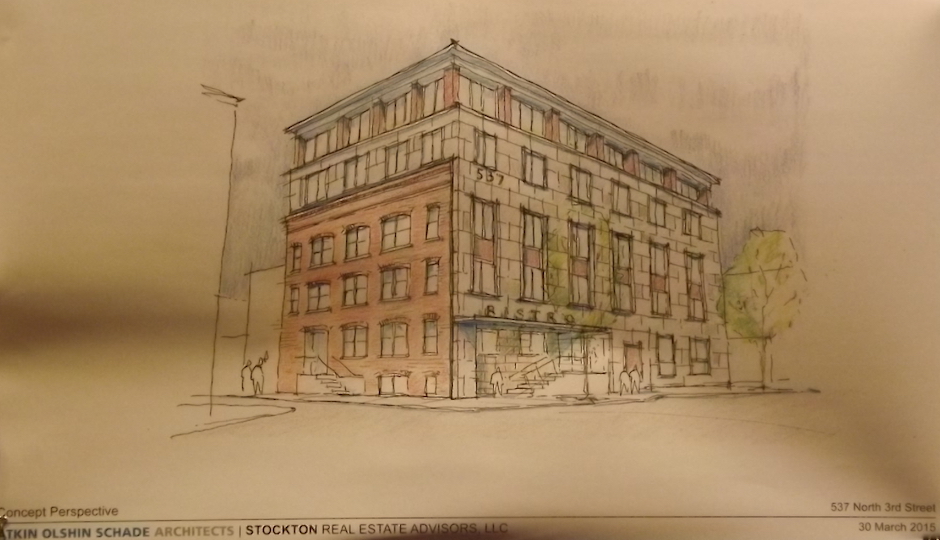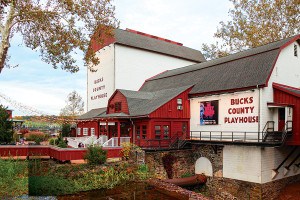NLNA Gives Finnigan’s Wake Conversion Plans A Trim

Early Conceptual designs show that Finnigan’s Wake could look dramatically different. | Image: Sandy Smith | Designs: Atkin Olshin Schade Architects
There have been times when the Northern Liberties Neighbors Association Zoning Committee has stopped developments in their tracks because of the strong objections of a single near neighbor.
That didn’t happen at the committee’s March 30 meeting, and boy, was that neighbor pissed about that.
Instead, the committee expressed general approval of a plan to build an addition on top of the former Finnigan’s Wake at Third and Spring Garden streets and only asked that the developer take about 20 feet off of the proposed 75-foot-high structure.
Architect Sam Olshin of Atkin Oshin Schade Architects, presenting on behalf of developer Stockton Real Estate Advisors, explained that the addition, consisting of two stories and a roof deck with pilot house access, was necessary to make Stockton’s proposal work financially. Stockton, which has an agreement of sale to buy the Finnigan’s building from owner Mike Driscoll, plans to convert the building into office space with one retail space on the first floor; Olshin said that the developer would like to see a bistro or cafe in the space.
Olshin also explained that this proposal emerged from preliminary discussions with NLNA Zoning Committee Chair Larry Freedman and other committee members, from whom Stockton sought advice on how best to reuse the building. Both residential and office space had been considered; the committee recommended the office project because it would not increase demand for overnight parking in the neighborhood.
The two stories would bring the building height to 68 feet, and the roof deck pilot house on the north side, along Green Street, would bring the total height on that side to 75 feet.
This raised the hackles of Jennifer Baker, who lives in a building at 601 N. 3rd, across Green Street from the building. “I seriously object to any additional height to this building and will fight anything that adds to it,” she said. Preliminary sun studies the developer presented showed that the bigger building would throw Baker’s apartment building into shadow for much of the fall, winter and spring.
Another resident, Tobias Wolff, did not object to the proposal in principle—”First, any use for the building is better than the existing one, and yes, this will be a financially attractive building,” he said—but he too wondered whether the building needed to be as tall as it was. Stockton founder and principal Jim Paterno, who was also present for the presentation, explained to him that “without additional height, this building will remain as it is, and it will probably be sold to someone who will open another bar and pub. This building is not large enough to make the necessary renovations to make it a viable structure” for other purposes, he said.
Olshin said that the building’s bones made it highly appealing as workspace for tech companies: built in the 1880s as a casket factory, the building has thick timber support beams and high ceilings. The roof deck would be an amenity for the office tenants, he said, but might also be used for receptions and community events.
Besides height, the other chief worries voiced by those in attendance concerned parking and the possibility, however remote, that another Finnigan’s Wake would take root in the retail space or on the roof deck. One resident asked point blank, “What’s there to stop [the restaurant] from becoming another pub crawl place?” Stockton replied, “We’re there to stop the restaurant from becoming another pub crawl place.” Freedman pointed out to his neighbors that even though the building has its liquor license, if it changes hands, the new owner must specify the total square footage of the licensed space in the application.
Freedman noted that the main reasons for the addition were financial—”The sale price is too high,” he said—and that the Zoning Board of Adjustment does not consider economic hardship sufficient grounds for granting a variance. Wolff was not completely convinced that the building needed to be remade in the fashion Olshin outlined either: “I want to see the case for something other than economics for building this,” he said.
One of the younger residents in attendance, Jennifer Ouellette, offered one: The building represents the future of the neighborhood. “I live on Spring Garden Street. I walk to work,” she said. “We need to think of the future, and the future is transit-oriented development.” Sitting as it does near the gateway to Northern Liberties, with two bus routes passing it and a Market-Frankford Line station a block away, the Finnigan’s building would indeed seem ripe for transit-oriented reuse, and younger tech workers have already demonstrated a preference for walkable work environments. (Olshin said it was the developer’s hope that workers in the offices would get out and take advantage of the neighborhood’s other amenities.) When one older resident objected to the project on the grounds that it would bring “too many people” (and cars) to the neighborhood, Ouellette responded, “There aren’t enough jobs in the neighborhood.” One committee member backed her up: “Parking isn’t an issue because things are changing. Soon people will think it’s crazy to drive in to work and park.”
It turned out that there was a middle way out for this proposal. The project will need variances in part because its lot is zoned CMX-2, which has the same 38-foot height limit that covers all the residential areas of Northern Liberties. But nearby commercial lots on Second Street, which is narrower than Spring Garden, are zoned CMX-2.5, which allows buildings up to 55 feet high by right. After expressing some incredulity that this lot was not likewise zoned, the neighbor suggested that the committee could ask that it conform to CMX-2.5 zoning, and the committee members agreed.
But Baker remained adamant in her objections, even after it was pointed out that the building she lives in is itself 60 feet high. Several committee members, including Freedman, also noted that they had lost light and air as a result of developments that proved good for the neighborhood, which probably made them less sympathetic to Baker’s objections: “It’s not like someone is going to throw a tarp over your yard,” said one member.
The divisions in the audience, however, led Freedman to put the question to a straw poll of residents. That poll showed Baker was almost alone in her objections: Three people agreed that the building should stay at its current height. Another three said the proposal should proceed as submitted. The remaining 17 residents voted to support reconfiguring the addition to bring the height down to the 55 feet allowed under CMX-2.5 zoning.
As this presentation was merely informational, the committee’s motion to ask the developer and architect to make that change means only that, as they had intended. Sam Olshin confirmed in an email the team will return on April 27 with another set of drawings “that addresses their concerns regarding height.”


